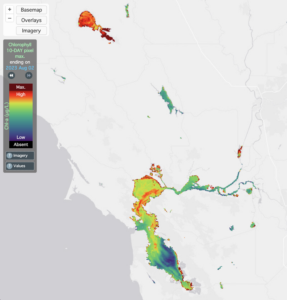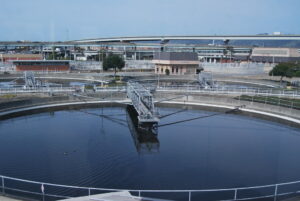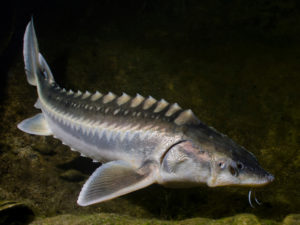The herring are running again in San Francisco, and it’s quite a show. Commercial fishing boats cast their nets in China Basin, at the mouth of Mission Creek, in the shadow of the Giants ballpark, and dozens of anglers threw small nets from piers and wharves all along the waterfront in Mission Bay.
Birding expert and fisherman Josiah Clark showed up to watch birds, though he’d put away 200 pounds of fish the day before. He said the fish will likely keep spawning—and the show will go on right offshore–through tomorrow, January 10. (Many more herring will soon be spawning in Richardson Bay and off Crissy Field, likely later this month.)
It was a bit of a feeding frenzy: people fishing, gulls diving, sea lions working the schools. “Half of these guys are already full,” said Clark. “They’re just waiting to digest. The seals get this look where they’re so full, huge, and fat. Even though there’s all this food below them, they just float there. That’s the strategy of the herring: if there’s enough, some get through.”
There seemed to be enough today. “This is the thickest I’ve seen it in 20 years,” said Nick Hayden, who’s lived in the area for decades. He was watching the action at Agua Vista Park, where anglers worked off the pier pulling in the wriggling six-inch fish, two commercial boats were hauling in purse seine nets, and sea lions, gulls, and pelicans worked the water just offshore.
[slideshow]
But Hayden was somewhat worried at the same time: “The bad news is that once these folks find out the fish are back, they might do it all over again. But I think Fish and Game [now fish and Wildlife] has a quota.”
They do indeed, and the rules governing the herring fishery were much on the mind of Anna Weinstein, Audubon California’s seabird conservation coordinator, who came out to watch the fish, birds, and other wildlife.
“There’s been a recovery of biomass from the lows of eight years ago,” she said. That’s been due partly to excellent ocean conditions but also to a conservative quota set by state fishing regulators. That dictates that five percent of the estimated herring biomass can be caught by the fleet. The people fishing from shore need a license, but they aren’t subject to catch limits. “These guys are catching a fraction of what the boats are doing,” Weinstein said.
But the apparently healthy run this season doesn’t mean there’s no cause for concern. The fish hauled in are getting younger and younger — truncated age classes, in fish management parlance. Weinstein pointed out that the fish caught today are almost all two and three years old. According to a commentary Audubon and others submitted to the state last fall, fishing data from the last 30 years show that eight-year-old fish dropped out in 1983, seven-year-olds in 1999, and six-year-olds in 2011. Four-year-olds were at historic lows starting in 2008.
State regulators “can’t explain it, and they’re worried about it,” said Weinstein. “And they should be. It’s not healthy to have that truncation.”
Why it’s happening is no simple matter. “It’s a mystery,” said Weinstein. “Where are these older fish going? The fishermen are saying they’re not taking them, they’re not appearing in survey catches, and the fishermen are only taking 5 percent or less of the total.”
Weinstein has spoken to a number of local marine ecosystem experts who have a theory that rebounding populations of seals, sea lions, and humpback whales are simply eating the older fish.
There’s not much to be done about that (except maybe celebrate), but the herring might benefit if we locals started eating more of them as well. At one time, most herring were caught for their roe, considered a delicacy in Japan and elsewhere. At the peak in the late 1980s, the fish went for thousands of dollars a ton. Today, it’s more like $300 a ton, and many of the fish are going into fish meal for pet food or other industrial products.
And good luck finding San Francisco Bay herring in the market. “Normal people can help by asking for it and being willing to try it and ordering it when it appears on menus,” said Weinstein. “Think about wild salmon: One reason there are still wild salmon is because fishermen are demanding it. We don’t want all our fish to come from Indonesia. We have a great productive system, so we should use it if we can use it responsibly. What’s less cool is how the fish are being used.”
Wildlife know what to do with them: They’re eaten not just by seals and sea lions, but also by seven or eight kinds of gulls, surf scoters and other ducks, salmon and other fish.
So don’t miss the show: Head to Agua Vista Park on January 10, 2013, or keep an eye out in Richardson Bay and off Crissy Field. The herring are in!
Here’s a video from Audubon:





